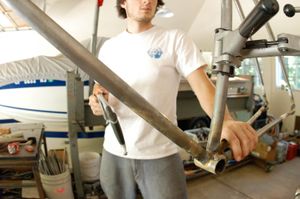One of the more interesting aspects of hanging out around young kids is watching them fail at something. Kids are constantly failing at something, and the ways in which they might misunderstand a problem (and misapply solutions to it) are surprising, and enlightening, and funny.
But as with a lot of parenting, watching my own kids fail can be terrifying. Not because of any imminent danger, but because managing, accepting, and responding to failure are all skills that I wish I was better at.
When someone fails at something over and over again, we call that practicing. It’s a word that my kids seem to have an innate repulsion to, and which I know I avoided as a child as well. To practice is to admit that you could improve, and also that you desire to improve – things I’m sure I was afraid to admit as a middle schooler, and which aren’t exactly natural to me now. But as I’ve gotten older, I’ve found that deliberate practice – failing at something over and over again with purpose – is one of the most gratifying things I can do.
PLANNING & STRATEGY.
Ah, the number of things I’ve repeatedly failed at! Just this week, I’ve repeatedly failed to write this very newsletter – spending hours with the draft open, meandering from thought to introspective thought. Calling this “practice” feels like a rhetorical sleight of hand, but on days when I *don’t* do it, I’m left with a sense that I’m neglecting something.
In my experience, the life of a small business owner involves doing a *lot* of things that you are not good at. Most of my time is spent hovering right on the edge of failure on like four different work streams. To be fair, failure is relative to one’s own expectations, and I suppose the upside of small business ownership is that you get to decide what the business’s expectations are. Nevertheless, I don’t think I’m the first person to associate “running a small business” with “constantly being just a little bit out of your depth.” I suppose that the natural question is whether the repeated failures of a small business owner result in some form of mastery over time. But again, mastery is relative to one’s expectations, and I suspect that for most small business owners it is more interesting to have built something that doesn’t break down while you’re on vacation than it is to have developed any specific management or operational skill.
In his infamous 2009 essay titled Maker’s Schedule, Manager’s Schedule, Paul Graham suggested that “founders may increasingly be able to resist, or at least postpone, turning into managers, just as a few decades ago they started to be able to resist switching from jeans to suits.” The sentiment resonates with me, and recently I’ve begun to think that perhaps my pendulum has swung too far in the “chief dilettante” direction (a euphemism I use to describe my daily mix of activities) and not far enough in the “founding writer” direction. Then again, as Tom Vanderbilt explains in his heartwarming and energizing book Beginners, dilettante is derived from the Italian word dilettare – to delight. And I suspect that I am not alone among small business owners who find some delight in their daily failures.
Read the full story
The rest of this post is for paid members only. Sign up now to read the full post — and all of Scope of Work’s other paid posts.
Sign up now

